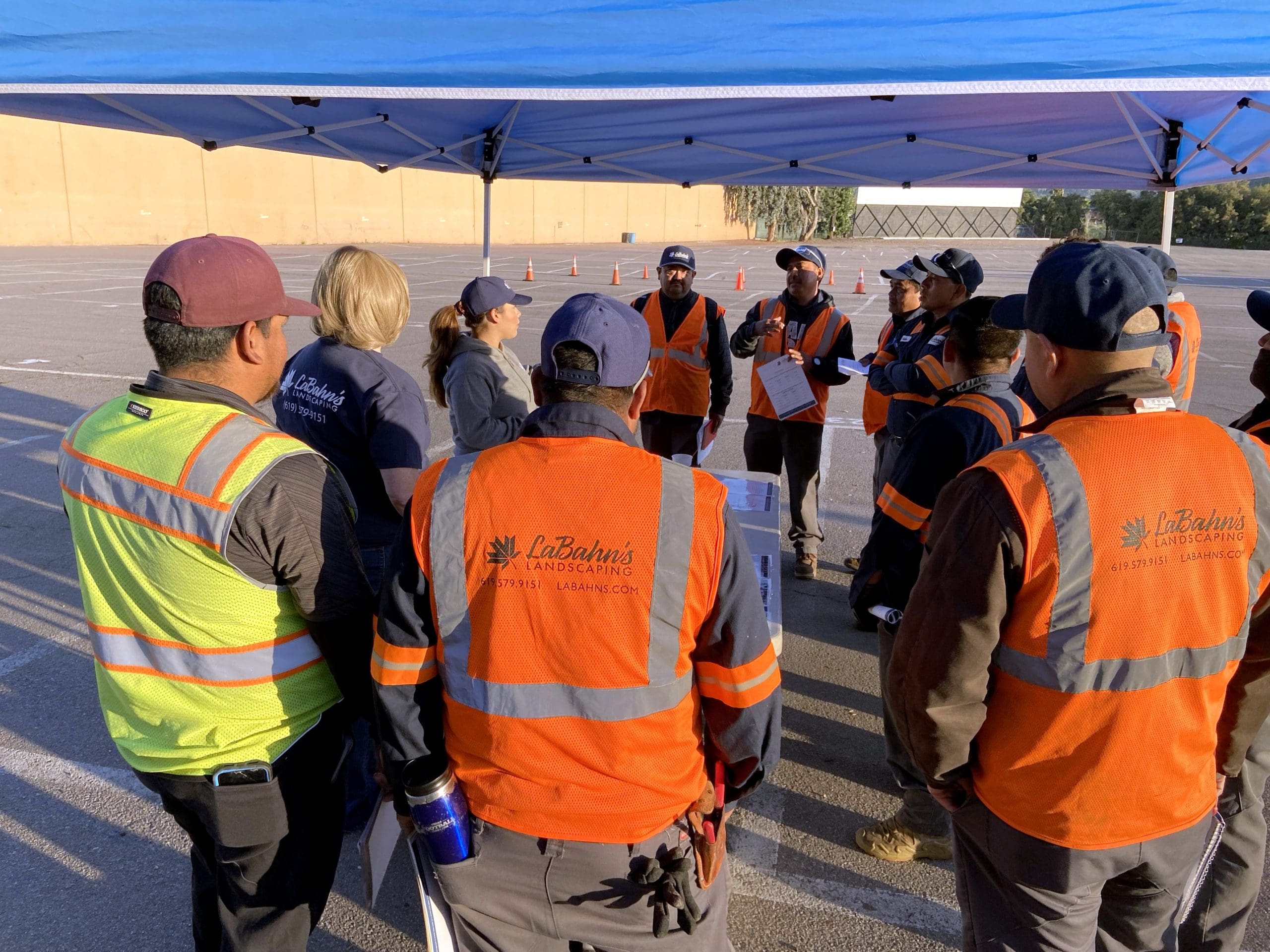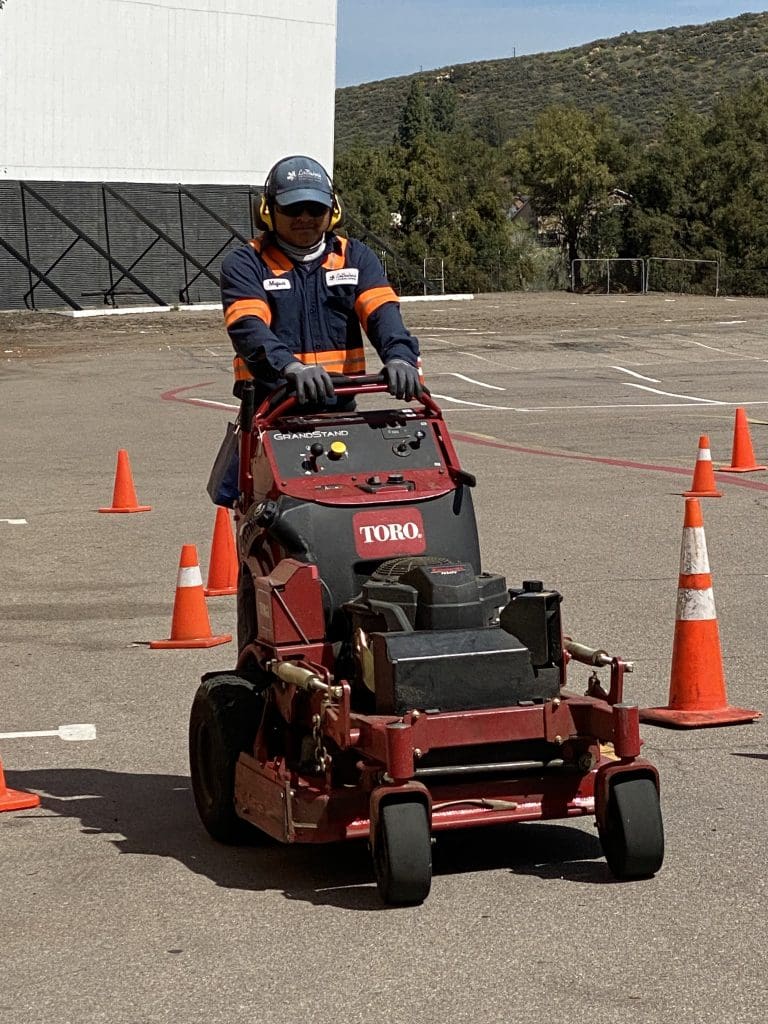
Statistically, the first six to 12 months with a landscape company are the most dangerous period for new employees. By taking the time to ensure proper safety training from the start, you can help lower this high incidence level for your new hires.
While it may seem like common sense to include safety training in your onboarding process, as you continue to grow your business, it’s a good idea to have this type of training organized.
“Things go astray very quickly if it’s not dialed in from day one,” says Brian Connors, president of Peak Landscape, Inc., based in Truckee, California.
Taylor Heisey, director of operations for LaBahn’s Landscaping, based in Santee, California, says the number of incidents has drastically decreased with their newer training and safety program.
“In addition to creating a safer environment, we started using a company called Onsite Health and Safety,” Heisey says. “These trained healthcare professionals provide 24-hour first aid to injuries. Adding this service has helped keep our employees safe since Onsite can come to the jobsite or the office same-day to assist with any injuries when they occur.”
What to Cover
Heisey says they cover their safety and PPE policies during onboarding, which takes about two hours. Then the production management team takes the new employee to their warehouse to train them on the correct and incorrect ways to use all the equipment. He adds they are working on a year-long safety and training program that all employees can access via an app.

“I think basic safety information can be often overlooked as we all take for granted what we assume people know,” Heisey says. “Reviewing policies can be helpful, but hands-on training and working one-on-one with the employees is always the best way to make sure they are trained and safe in all aspects of their job. I always make sure our employees know that it is our job to make them feel safe so they can go home to their families at the end of each day.”
Joe Lewis, COO of Yard Solutions, based in Groveport, Ohio, says they have a PowerPoint presentation that addresses PPE, fire and fuel safety, heat and cold stress safety, landscape hazards and hazard communication.
“I feel hazard recognition and who the employee should go to for questions is often overlooked,” Lewis says. “I recommend approaching all training with the intent to make it easier to do the right thing. Essentially, focus on developing sound habits from orientation as a new employee through a tenured manager. Too often, the focus is on the consequence after something bad occurs, rather than developing effective habits and reinforcing that behavior.”
Connors says they bring on their new hires in the spring and take them through various safety stations. Depending on the position they’re going into, the focus will change. He says they continue safety meetings every Monday about a relevant topic so everyone is on the same page throughout the season.
“In the spring, we’ll try and bring all new hires in for a couple of days and just have them at our yard and just go through different areas of concern as far as small engine equipment, working around large equipment all the way down to hand tool safety and basic PPE as far as ears, eyes, dust masks, so on and so forth,” Connors says.
Connors notes that depending on the new hire’s background, they might not be used to wearing PPE or accustomed to a safety culture.
“That’s definitely a massive challenge,” Connors says. “Taking them and taking those bad practices that they’ve been taught over the course of years and molding them into somebody who’s actually safety conscious.”
Ensure Comprehension
Conducting initial safety training during onboarding is important, but it’s equally critical to ensure your new employees grasp the concepts.
Following the review of safety and PPE policies and the demonstration of equipment use, LaBahn’s new employees take a short quiz to ensure they’ve understood everything. Lewis says they also conduct a multiple-choice test covering the basics.
At Yard Solutions, they have the new employee assigned to a crew with one of their in-house trainers for at least two weeks. This is one of the ways they help their new hires feel comfortable enough to ask questions on the job. Lewis says they focus on covering safety content that is relatable and ensuring their leaders are engaged.

“You would be amazed at the power of being available and asking people how they are doing and if there is anything you can do for them,” Lewis says.
Heisey says they conduct regular check-ins with their new employees throughout the first few weeks and let them know they are available to help with anything they need.
“The direct supervisor of the new hire is the one that greets them on their first day and walks them through the warehouse, which helps to create a bond from the start,” Heisey says. “This helps new hires feel comfortable and valued, so they are more inclined to ask questions.”
Connors stresses to his team that the only stupid question is the one you don’t ask. He says during their weekly safety meetings, they have two circles, one in English and one in Spanish, just to make sure everybody understands fully.
“I think it makes people more comfortable that if they are going to ask a question, they can ask it in the Spanish circle,” Connors says.
Common Mistakes
The opposite of neglecting to touch on safety topics during onboarding is overloading new hires with a four-hour lecture on everything safety-related.
“I believe if you want to teach someone nothing, show them everything,” Lewis says. “Training should be structured to the level of the employee being onboarded (maintenance, mechanic, construction, management, office, etc.) The training should also cover the basic functions and hazard recognition for a successful first week. Leadership engagement can expand on the necessary skills in a more comprehensive format while on the job.”
Another common failure is investing in thorough safety training leading up to the spring season for new hires but not providing the same level of training to employees who join your company later in the season. Connors admits they are working to improve this at their own company.
“I feel like the longer the season goes, the less we really focus on that, which is something that we’re looking to curb and something we’re looking to improve upon for sure,” Connors says.
Heisey adds it’s important not to assume all new employees know how to properly use PPE, even if they’ve previously used it.
“While many people understand what PPE is and what it is used for, they often forget or take shortcuts to be more productive,” Heisey says. “Assessing their knowledge and helping them remain safe is always our priority, and we understand that some people may need a refresher.”
This article was published in the May/June issue of the magazine. To read more stories from The Edge magazine, click here to subscribe to the digital edition.

